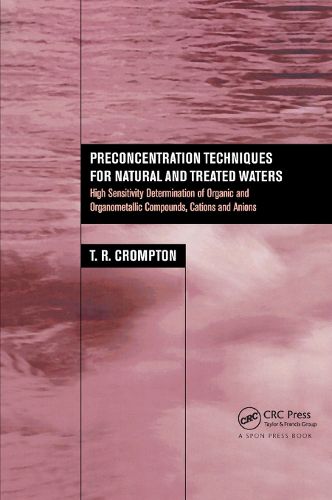Readings Newsletter
Become a Readings Member to make your shopping experience even easier.
Sign in or sign up for free!
You’re not far away from qualifying for FREE standard shipping within Australia
You’ve qualified for FREE standard shipping within Australia
The cart is loading…






Equipment used for the analysis of water is frequently insufficiently sensitive to be able to detect the low concentrations of organic and inorganic substances present in samples. Applying preconcentration to the sample prior to analysis means the results gained are more accurate and can be used to report trends more effectively.
Each chapter of Preconcentration Techniques for Natural and Treated Waters discusses a different method of preconcentration and its application to the preconcentration of cations, anions, organic substances and organometallic compounds. Drawing together the recent world literature available on the subject, this book provides detailed discussion of the need for reducing detection limits in analytical chemistry and ways of achieving this aim. Throughout the book emphasis is laid on providing practical experimental detail, facilitating further development of procedures. Numerous tables present information clearly and accessibly.
This book will be an invaluable reference for biologists, chemists, agriculturists, toxicologists, oceanographers, and environmentalists dealing with the analysis of water in industry and academia.
$9.00 standard shipping within Australia
FREE standard shipping within Australia for orders over $100.00
Express & International shipping calculated at checkout
Equipment used for the analysis of water is frequently insufficiently sensitive to be able to detect the low concentrations of organic and inorganic substances present in samples. Applying preconcentration to the sample prior to analysis means the results gained are more accurate and can be used to report trends more effectively.
Each chapter of Preconcentration Techniques for Natural and Treated Waters discusses a different method of preconcentration and its application to the preconcentration of cations, anions, organic substances and organometallic compounds. Drawing together the recent world literature available on the subject, this book provides detailed discussion of the need for reducing detection limits in analytical chemistry and ways of achieving this aim. Throughout the book emphasis is laid on providing practical experimental detail, facilitating further development of procedures. Numerous tables present information clearly and accessibly.
This book will be an invaluable reference for biologists, chemists, agriculturists, toxicologists, oceanographers, and environmentalists dealing with the analysis of water in industry and academia.